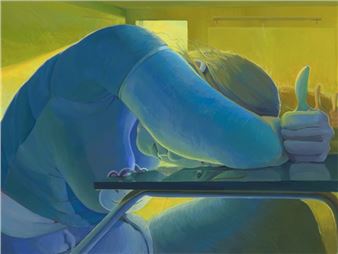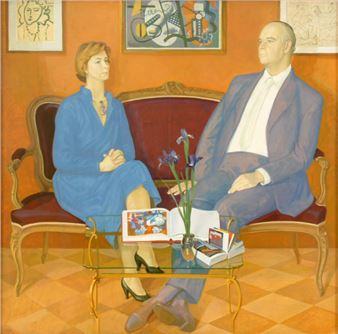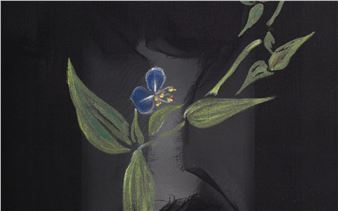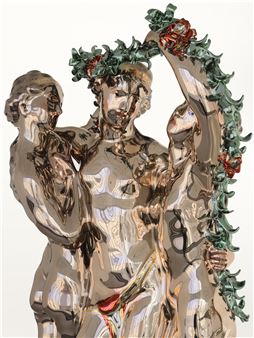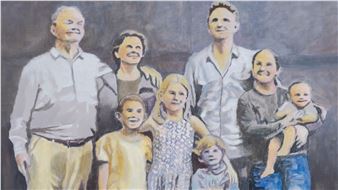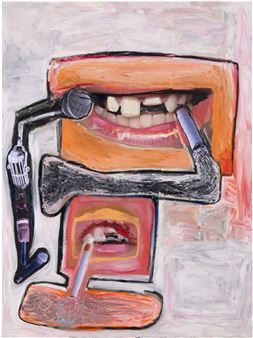JГіzsef CsatГі: Crossing The Invisible
Sean Horton (Presents) is pleased to announce the New York solo debut of Hungarian painter JГіzsef CsatГі вҖ” the exhibition is the first in a year-long series to be held at 515 West 20th Street, 3rd Floor in the Chelsea neighborhood of New York City.
In what has become his signature style, the paintings of JГіzsef CsatГі are rooted in a practice that the artist refers to as вҖңsketchbook mythologies.вҖқ Emerging from a sort of doodleвҖҷs paradise, the artistвҖҷs mostly biomorphic, yet personified, pencil drawings sometimes sprout from page to canvas where they join others to build a brave new world.
Calling his studio a вҖңmicrocosmвҖқ where ideas вҖңfertilizeвҖқ others, the resulting paintings often establish a relationship between the natural and the human-made. And while the scenes are not overtly dystopian, there is the slightly sinister implication that we have just missed some sort of event or that we may be to blame for the interruption. In Calibrating Feelings (all works 2021), colorful stems and stalks are stuffed into pastel pottery-like containers that are hovering around a woodgrain-like surface with glowing eyes вҖ” one canвҖҷt help but think of that not-entirely-welcoming jangle of the shopkeeperвҖҷs bell that causes us to adjust to the sudden stillness of our local florist. вҖңJust lookingвҖҰвҖқ we say to alleviate the tension.
While CsatГі paints mostly intuitively, there is a sense of display or organization that brings to mind words like diorama, menagerie, or collection, however, the experience of these scenes is freely meandering. For example, Finally We Meet could easily be a fairy tale version of an afternoon walk through a sculpture garden or a natural history museum вҖ” one where the artistвҖҷs turquoise overpainting recedes to become a sky with heavy, colorful clouds and the bulbous MirГі-like form is guarded by the weathered minerality of some sort of beastвҖҰmaybe prehistoric, maybe friendly? In Butterfly Trap II, a scene is set, in dramatic form, for a bashful central character that is ever-so-slightly revealed through Wisteria-colored curtains, but on this occasion the artistвҖҷs employment of a bone-colored surface melds into the shape of a bell jar.

Recommended for you
Sean Horton (Presents) is pleased to announce the New York solo debut of Hungarian painter JГіzsef CsatГі вҖ” the exhibition is the first in a year-long series to be held at 515 West 20th Street, 3rd Floor in the Chelsea neighborhood of New York City.
In what has become his signature style, the paintings of JГіzsef CsatГі are rooted in a practice that the artist refers to as вҖңsketchbook mythologies.вҖқ Emerging from a sort of doodleвҖҷs paradise, the artistвҖҷs mostly biomorphic, yet personified, pencil drawings sometimes sprout from page to canvas where they join others to build a brave new world.
Calling his studio a вҖңmicrocosmвҖқ where ideas вҖңfertilizeвҖқ others, the resulting paintings often establish a relationship between the natural and the human-made. And while the scenes are not overtly dystopian, there is the slightly sinister implication that we have just missed some sort of event or that we may be to blame for the interruption. In Calibrating Feelings (all works 2021), colorful stems and stalks are stuffed into pastel pottery-like containers that are hovering around a woodgrain-like surface with glowing eyes вҖ” one canвҖҷt help but think of that not-entirely-welcoming jangle of the shopkeeperвҖҷs bell that causes us to adjust to the sudden stillness of our local florist. вҖңJust lookingвҖҰвҖқ we say to alleviate the tension.
While CsatГі paints mostly intuitively, there is a sense of display or organization that brings to mind words like diorama, menagerie, or collection, however, the experience of these scenes is freely meandering. For example, Finally We Meet could easily be a fairy tale version of an afternoon walk through a sculpture garden or a natural history museum вҖ” one where the artistвҖҷs turquoise overpainting recedes to become a sky with heavy, colorful clouds and the bulbous MirГі-like form is guarded by the weathered minerality of some sort of beastвҖҰmaybe prehistoric, maybe friendly? In Butterfly Trap II, a scene is set, in dramatic form, for a bashful central character that is ever-so-slightly revealed through Wisteria-colored curtains, but on this occasion the artistвҖҷs employment of a bone-colored surface melds into the shape of a bell jar.
Artists on show
Contact details


 ARTISTS
ARTISTS







